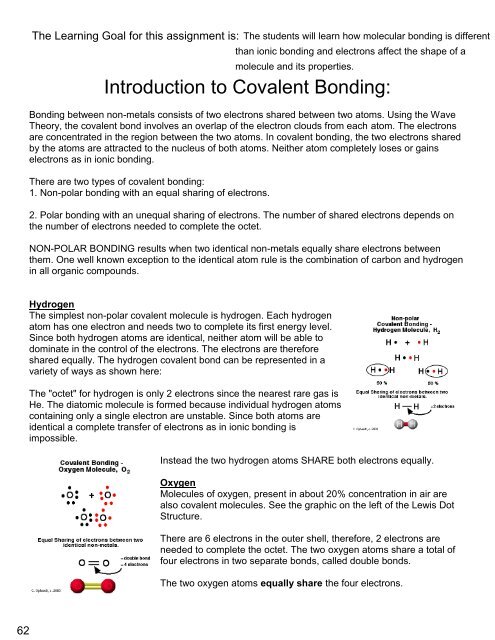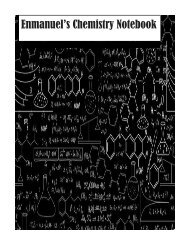Create successful ePaper yourself
Turn your PDF publications into a flip-book with our unique Google optimized e-Paper software.
The Learning Goal for this assignment is:<br />
Introduction to Covalent Bonding:<br />
Bonding between non-metals consists of two electrons shared between two atoms. Using the Wave<br />
Theory, the covalent bond involves an overlap of the electron clouds from each atom. The electrons<br />
are concentrated in the region between the two atoms. In covalent bonding, the two electrons shared<br />
by the atoms are attracted to the nucleus of both atoms. Neither atom completely loses or gains<br />
electrons as in ionic bonding.<br />
There are two types of covalent bonding:<br />
1. Non-polar bonding with an equal sharing of electrons.<br />
2. Polar bonding with an unequal sharing of electrons. The number of shared electrons depends on<br />
the number of electrons needed to complete the octet.<br />
NON-POLAR BONDING results when two identical non-metals equally share electrons between<br />
them. One well known exception to the identical atom rule is the combination of carbon and hydrogen<br />
in all organic compounds.<br />
Hydrogen<br />
The simplest non-polar covalent molecule is hydrogen. Each hydrogen<br />
atom has one electron and needs two to complete its first energy level.<br />
Since both hydrogen atoms are identical, neither atom will be able to<br />
dominate in the control of the electrons. The electrons are therefore<br />
shared equally. The hydrogen covalent bond can be represented in a<br />
variety of ways as shown here:<br />
The "octet" for hydrogen is only 2 electrons since the nearest rare gas is<br />
He. The diatomic molecule is formed because individual hydrogen atoms<br />
containing only a single electron are unstable. Since both atoms are<br />
identical a complete transfer of electrons as in ionic bonding is<br />
impossible.<br />
Instead the two hydrogen atoms SHARE both electrons equally.<br />
Oxygen<br />
Molecules of oxygen, present in about 20% concentration in air are<br />
also covalent molecules. See the graphic on the left of the Lewis Dot<br />
Structure.<br />
There are 6 electrons in the outer shell, therefore, 2 electrons are<br />
needed to complete the octet. The two oxygen atoms share a total of<br />
four electrons in two separate bonds, called double bonds.<br />
The two oxygen atoms equally share the four electrons.




